Density 1.64 g/cm³ Boiling point 105.8 °C Melting point 1.25 °C | Formula POCl3 Molar mass 153.33 g/mol | |
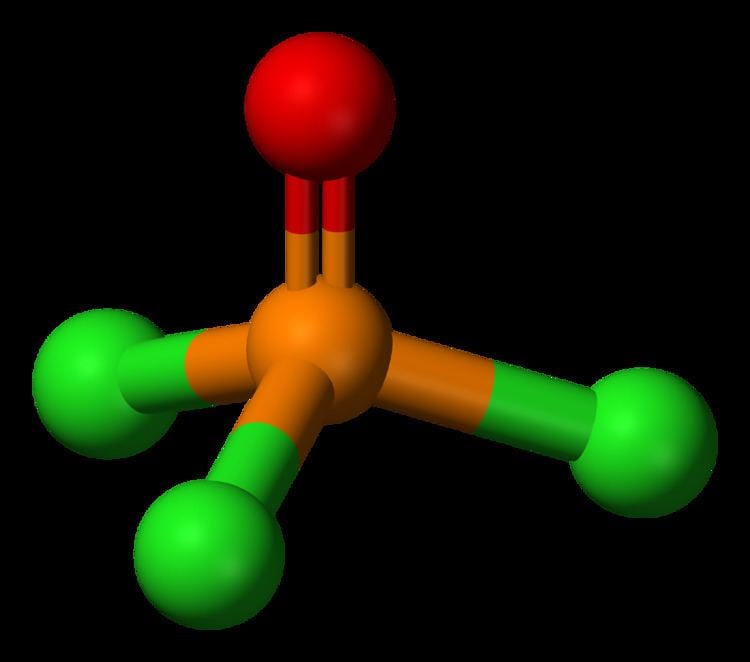 | ||
Appearance Clear, colourless liquid, fumes in moist air Related compounds Thermodynamicdata Phase behavioursolid–liquid–gas | ||
Phosphoryl chloride
Phosphoryl chloride (commonly called phosphorus oxychloride) is a colourless liquid with the formula POCl3. It hydrolyses in moist air releasing phosphoric acid and choking fumes of hydrogen chloride. It is manufactured industrially on a large scale from phosphorus trichloride and oxygen or phosphorus pentoxide. It is mainly used to make phosphate esters such as tricresyl phosphate.
Contents
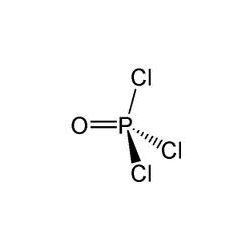
Structure
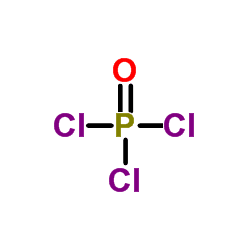
Like phosphate, phosphoryl chloride is tetrahedral in shape. It features three P-Cl bonds and one strong P=O double bond, with an estimated bond dissociation energy of 533.5 kJ/mol. On the basis of bond length and electronegativity, the Schomaker-Stevenson rule suggests that the double bond form is very dominant (in contrast with POF3). The P=O bond does not utilize the d-orbitals on phosphorus as is commonly described in older textbooks as quantum chemical calculations have shown that d-orbitals are not involved in main group chemical bonding (see Hypervalent molecule). More modern texts favour a description which involves the donation of the lone pair electrons from oxygen p-orbitals to the antibonding phosphorus-chlorine bonds thus constituting π bonding.
Physical properties
With the freezing point of 1 °C and boiling point 106 °C, the liquid range is rather similar to water.
Chemical properties
POCl3 reacts with water and alcohols to give hydrogen chloride and phosphoric acid or phosphate esters, respectively:
O=PCl3 + 3 H2O → O=P(OH)3 + 3 HCl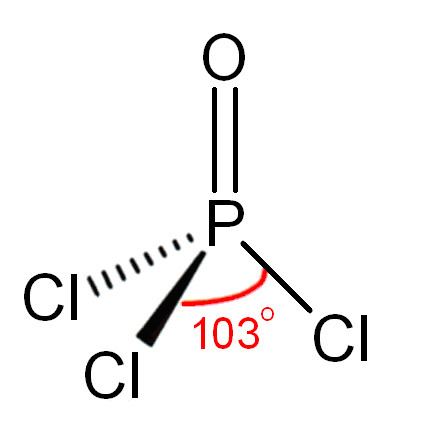
If the water is replaced by an alcohol, the trialkyl phosphate esters result. Such reactions are often performed in the presence of an HCl acceptor such as pyridine or an amine. If POCl3 is heated with an excess of a phenol (ArOH) in the presence of a Lewis acid catalyst such as magnesium chloride, a triaryl phosphate ester such as triphenyl phosphate is formed. For example:
3 C6H5OH + O=PCl3 → O=P(OC6H5)3 + 3 HCl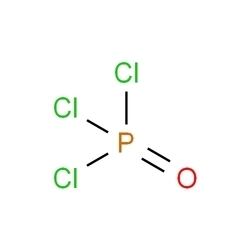
POCl3 can also act as a Lewis base, forming adducts with a variety of Lewis acids such as titanium tetrachloride:
Cl3P+-O− + TiCl4 → Cl3P+-O−-TiCl4The aluminium chloride adduct (POCl3·AlCl3) is quite stable, and so POCl3 can be used to remove AlCl3 completely from reaction mixtures at the end of a Friedel-Crafts reaction. POCl3 reacts with hydrogen bromide in the presence of AlCl3 to produce POBr3.
Preparation
Phosphoryl chloride can be prepared by various methods, notable examples include:
5) with phosphorus pentoxide (P
4O
10). The reaction can be simplified by chlorinating a mixture of PCl3 and P4O10, generating the PCl5 in situ. As the PCl3 is consumed, the POCl3 products become a solvent for the unreacted solid starting reagents:
Uses
The most important use for phosphoryl chloride is in the manufacture of triarylphosphate esters (as described above) such as triphenyl phosphate and tricresyl phosphate. These esters have been used for many years as flame retardants and plasticisers for PVC. Meanwhile, trialkyl esters such as tributyl phosphate (made similarly from butan-1-ol) are used as liquid-liquid extraction solvents in nuclear reprocessing and elsewhere.
In the semiconductor industry, POCl3 is used as a safe liquid phosphorus source in diffusion processes. The phosphorus acts as a dopant used to create N-type layers on a silicon wafer.
In the laboratory, POCl3 is widely used as a dehydrating agent, for example the conversion of primary amides to nitriles. Similarly, certain aryl amides can be cyclised to dihydroisoquinoline derivatives using the Bischler-Napieralski reaction.
Such reactions are believed to go via an imidoyl chloride; in certain cases where it is stable, the imidoyl chloride is the final product. For example, pyridones and pyrimidones can be converted to chloro- derivatives of pyridines and pyrimidines, which are important intermediates in the pharmaceutical industry.
Another common laboratory use for POCl3 is in the Vilsmeier-Haack reaction, where it reacts with amides to produce a "Vilsmeier reagent," a chloro-iminium salt, which subsequently reacts with electron-rich aromatic compounds to produce aromatic aldehydes upon aqueous work-up.
